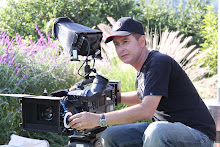
These days all the buzz is about new cameras such as the RED ONE or video DSLR 35mm still/video cameras and a myriad of palmcorders, which get better and better. It seems that the old faithful, 2/3" 3-CCD, ENG shoulder mount camera is just not getting much attention anymore.
There is no doubt that some of these new cameras are breaking new ground due to their large CMOS sensors, shallow depth of field, small form factors and low price. We know that no one camera can be the best choice for every kind of shoot, that's why SSV offers 1/3", 1/2" and 2/3" cameras and Letus Ultimate 35mm Cine adapters to go with all of them.
It occurs to us that there are many young filmmakers who may never have shot with 2/3" CCD cameras. With that in mind, here are some reasons why this type of camera can still be advantageous on many productions:
1. 2/3" CCD's are more light sensitive, have lower noise, shallower depth of field, can resolve small detail better, offer more latitude and have more image control parameters than most small sensor cameras.
2. 2/3" ENG form factor cameras are made for hand-held work, balancing properly on the shoulder and the larger mass makes tripod use easier. The viewfinders are usually superior as well.
3. 2/3" cameras have a wide variety of lenses available vs. smaller sensor cameras, typically with longer focal lengths and higher zoom ratios.
4. 2/3" tapeless cameras often have more recording capacity than palmcorders and video DSLR cameras, and no 5-12 minute record limit per take, unlike the latter.
5. 2/3" cameras are very rugged and durable, the technology is proven and the companies that offer them have many years of experience building them, offering parts and professional service infrastructure to support them worldwide.
6. 2/3" cameras feature professional level recording formats, tape or tapeless, they will offer proven work flows, less compression, higher bit rates, often better color space and more post production flexibility for grading and color correction.
7. 2/3" cameras tend to have better ergonomics with controls that are easier to see and get at.
8. 2/3" cameras often have better and more audio features and many have slots that can accept two-channel wireless mic. receivers internally.
9. 2/3" cameras are a lot easier to shoot with when it comes to depth of field and ergonomics vs. large sensor cameras, which have very shallow depth of field whether wanted or not. One ENG zoom lens often covers every shot needed with smooth, internal servo motors for iris and zoom functions.
10. Most professional crews are familiar with 2/3" cameras and they can be rented in most parts of the world.
11. Due to the light sensitivity and contrast handling that the best 2/3" cameras offer(about 10 f-stops), time and money can be saved by not having to control contrast via lighting and grip equipment and more crew vs. a small sensor palmcorder(about 7 f-stops at best).
The large sensor cameras are new to the scene and are not necessarily designed with video production in mind, having compromises and limitations, such as poor ergonomics and monitoring, constant firmware upgrades addressing certain issues while creating new ones, overheating, need for rebooting in the middle of a shoot, complex workflow, lack of in-camera control of the image, lack of internal image processing, short record time, and limited audio features. They aren't conducive to professional hand held work, very difficult to keep moving action in focus, low bit rate, highly compressed recording codecs, CMOS artifacts such as skewing with fast pans or motion, due to rolling shutter, moire, color fringing and aliasing on edges due to filtration of the single sensor, and IR contamination. Typically, multiple lenses are required to do the same thing a single 2/3" ENG zoom lens can.
Things are moving quickly in the realm of HD camera technology, but sometimes the tried and true approach is the best approach--productions are challenging enough without the camera being an additional risk factor.

